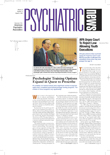Not everyone who is subjected to trauma later develops posttraumatic stress disorder (PTSD), but the very fact of being born female puts a person at greater risk, according to a psychiatrist who specializes in women's mental health issues.
The lifetime prevalence of PTSD for women—about 10.4 percent—is more than twice that for men.
Psychiatrists should also be aware that women with PTSD may have unique treatment needs, said Marian Butterfield, M.D., M.P.H., who spoke at APA's annual meeting in New York in May as part of a symposium on women's mental health issues sponsored by the Association of Women Psychiatrists.
Butterfield is an associate professor of psychiatry at Duke University and director of women's mental health at the Durham Veterans Affairs Medical Center.
Seldom do women patients who have sustained sexual trauma volunteer that information when they begin seeing a psychiatrist. The effects of sexual trauma may surface as depression, panic attacks, insomnia, suicidality, somatic complaints, or addiction, she said.
Butterfield urged psychiatrists to conduct a trauma history on patients during the initial visit, but to avoid the elicitation of “excruciating detail,” which can be upsetting for patients. “It's a delicate balance on the first interview—avoiding voyeurism and keeping boundaries intact,” she noted.
When determining whether a patient has experienced trauma, it is sometimes helpful for psychiatrists to make “normalizing” statements to let patients know that experiencing trauma is not uncommon before asking them if they have ever experienced trauma as a child or adult.
If the patient indicates that she has experienced sexual trauma, for example, the psychiatrist should ask about the relationship of the patient to the perpetrator, when the trauma occurred, the duration of the trauma, and the patient's perception of the effect of the trauma on her life, Butterfield said.
Empathizing with the patient can go a long way in helping her to feel supported, Butterfield emphasized. Many of her patients have relayed stories about “hostile treatment responses” from previous clinicians once they bring up the issue of trauma, she noted, such as not being believed.
“When I ask them how they wish people would have responded,” Butterfield said, “often the [desirable response] is as simple as saying, `I'm sorry that happened to you.'”
While assessing patients for PTSD, it is also critical to assess them for cormorbid disorders such as depression, anxiety disorders, and drug and alcohol abuse or dependence, she said. “Comorbid psychotic symptoms may be underdiagnosed in patients with PTSD” by clinicians, she said, and can include auditory and visual hallucinations in addition to paranoid delusions.
It is also necessary to screen for suicidality, since “PTSD patients are six times more likely to attempt suicide than the general population,” she said.
Although further research is needed to understand gender differences in the neurobiology of PTSD, Butterfield noted that the hypothalamic-pituitary-adrenal axis of women's brains may be more reactive in PTSD than is the case for men.
Butterfield pointed out that some women with PTSD have been found to release more adrenocorticotropic hormone and cortisol. “There is some question about whether this response is blunted in men,” she noted.
It is also thought that fluctuations of estrogen and progesterone may impact on hormonal modulation in neurotransmitter systems, Butterfield added.
Both medications and psychotherapy are used to treat the symptoms of PTSD. The goal of pharmacotherapy is to reduce symptoms of re-experiencing the trauma, avoidance, numbing, and hyperarousal.
“We want to treat associated comorbidities and improve the quality of life and resilience to stress by reducing the disability, stress, and vulnerability, and also to facilitate nonpharmacologic therapies,” Butterfield pointed out.
Selective serotonin reuptake inhibitors (SSRIs) are the first line of treatment for patients with PTSD because they are especially “well tolerated and safe,” she said, and tricyclic antidepressants have also been shown to be efficacious.
In instances in which SSRIs don't work for patients with PTSD, Butterfield suggested targeting specific symptoms with different medications. For instance, anti-adrenergic agents may work for hyperarousal symptoms, she said, and for paranoia, an atypical antipsychotic is recommended. Anticonvulsant medications may be helpful in reducing labile mood or impulsive behavior.
Although there has not been sufficient research on the efficacy of psychodynamic psychotherapy on PTSD, Butterfield noted, its objective is to explore the personal meaning of traumatic events, to “counter the demoralization that is so inherent in traumatic stress,” and to maintain a focus on the trauma.
Two types of cognitive-behavioral therapy have been studied and used in patients with PTSD. One uses systematic exposure to help patients confront feared situations, objects, or images, and the other employs anxiety-management exercises such as breathing, relaxation training, and cognitive restructuring to help patients reduce symptoms of anxiety associated with PTSD. ▪
